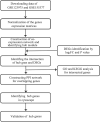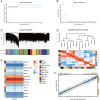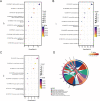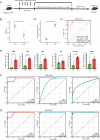Identification of hub genes associated with diabetic cardiomyopathy using integrated bioinformatics analysis
- PMID: 38961143
- PMCID: PMC11222523
- DOI: 10.1038/s41598-024-65773-z
Identification of hub genes associated with diabetic cardiomyopathy using integrated bioinformatics analysis
Abstract
Diabetic cardiomyopathy (DCM) is a common cardiovascular complication of diabetes, which may threaten the quality of life and shorten life expectancy in the diabetic population. However, the molecular mechanisms underlying the diabetes cardiomyopathy are not fully elucidated. We analyzed two datasets from Gene Expression Omnibus (GEO). Differentially expressed and weighted gene correlation network analysis (WGCNA) was used to screen key genes and molecules. Gene Ontology (GO), Kyoto Encyclopedia of Genes and Genomes (KEGG) enrichment analysis, and protein-protein interaction (PPI) network analysis were constructed to identify hub genes. The diagnostic value of the hub gene was evaluated using the receiver operating characteristic (ROC). Quantitative real-time PCR (RT-qPCR) was used to validate the hub genes. A total of 13 differentially co-expressed modules were selected by WGCNA and differential expression analysis. KEGG and GO analysis showed these DEGs were mainly enriched in lipid metabolism and myocardial hypertrophy pathway, cytomembrane, and mitochondrion. As a result, six genes were identified as hub genes. Finally, five genes (Pdk4, Lipe, Serpine1, Igf1r, and Bcl2l1) were found significantly changed in both the validation dataset and experimental mice with DCM. In conclusion, the present study identified five genes that may help provide novel targets for diagnosing and treating DCM.
© 2024. The Author(s).
Conflict of interest statement
The authors declare no competing interests.
Figures








Similar articles
-
Identification of key genes of diabetic cardiomyopathy in hiPSCs-CMs based on bioinformatics analysis.Mol Cell Biochem. 2024 Dec;479(12):3447-3458. doi: 10.1007/s11010-023-04915-9. Epub 2024 Feb 21. Mol Cell Biochem. 2024. PMID: 38381273
-
Integrated microarray analysis to identify potential biomarkers and therapeutic targets in dilated cardiomyopathy.Mol Med Rep. 2020 Aug;22(2):915-925. doi: 10.3892/mmr.2020.11145. Epub 2020 May 14. Mol Med Rep. 2020. PMID: 32626989 Free PMC article.
-
Identification of Core Gene Biomarkers in Patients with Diabetic Cardiomyopathy.Dis Markers. 2018 Dec 19;2018:6025061. doi: 10.1155/2018/6025061. eCollection 2018. Dis Markers. 2018. PMID: 30662576 Free PMC article.
-
Identification of key genes and pathways in castrate-resistant prostate cancer by integrated bioinformatics analysis.Pathol Res Pract. 2020 Oct;216(10):153109. doi: 10.1016/j.prp.2020.153109. Epub 2020 Jul 13. Pathol Res Pract. 2020. PMID: 32853947
-
Integrated Analysis of Hub Genes and Pathways In Esophageal Carcinoma Based on NCBI's Gene Expression Omnibus (GEO) Database: A Bioinformatics Analysis.Med Sci Monit. 2020 Aug 5;26:e923934. doi: 10.12659/MSM.923934. Med Sci Monit. 2020. PMID: 32756534 Free PMC article.
Cited by
-
Murine Model Insights: Identifying Dusp15 as a Novel Biomarker for Diabetic Cardiomyopathy Uncovered Through Integrated Omics Analysis and Experimental Validation.Diabetes Metab Syndr Obes. 2025 Feb 19;18:515-527. doi: 10.2147/DMSO.S501563. eCollection 2025. Diabetes Metab Syndr Obes. 2025. PMID: 39990179 Free PMC article.
-
Generalizability of machine learning models for diabetes detection a study with nordic islet transplant and PIMA datasets.Sci Rep. 2025 Feb 6;15(1):4479. doi: 10.1038/s41598-025-87471-0. Sci Rep. 2025. PMID: 39915538 Free PMC article.
References
MeSH terms
Substances
Grants and funding
LinkOut - more resources
Full Text Sources
Medical
Research Materials
Miscellaneous

